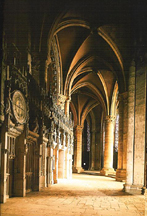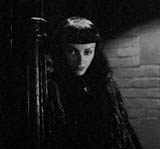Dark Energy
(page
2)
components
The Dark Energy list is held in bounds by the gravity of two genres: noir and gothic.
Noir:
 Any
definition of film noir will be
contested, but the term refers, more or less, to certain black-and-white
crime movies running from
The Maltese Falcon* in
1941 to Touch of Evil* in
1958, with 1944 being the year things jelled though no one knew
it at
the time.
The word "noir" is
French for "black" (better
translated as
"dark" for what we're up to here) and describes both
the look and the mood of these films. Film noir* is
not synonymous
with
detective movies or gangster movies. There are plenty of detectives
and gangsters in noir, but they can be there or not; it's
the look and the mood that count. Words like "paranoia," "alienation," "instability," "guilt," and "complexity" can
be appropriately applied. Where there's a crime, the protagonist
is as likely to have committed it as to be
trying
to
solve
it. One of the most widely appreciated aspects of noir is the character
known as the femme
fatale (French, meaning "deadly woman"), but even this
sacred icon is not an inevitable presence.
Any
definition of film noir will be
contested, but the term refers, more or less, to certain black-and-white
crime movies running from
The Maltese Falcon* in
1941 to Touch of Evil* in
1958, with 1944 being the year things jelled though no one knew
it at
the time.
The word "noir" is
French for "black" (better
translated as
"dark" for what we're up to here) and describes both
the look and the mood of these films. Film noir* is
not synonymous
with
detective movies or gangster movies. There are plenty of detectives
and gangsters in noir, but they can be there or not; it's
the look and the mood that count. Words like "paranoia," "alienation," "instability," "guilt," and "complexity" can
be appropriately applied. Where there's a crime, the protagonist
is as likely to have committed it as to be
trying
to
solve
it. One of the most widely appreciated aspects of noir is the character
known as the femme
fatale (French, meaning "deadly woman"), but even this
sacred icon is not an inevitable presence.
It's generally true that, in noir, tone trumps plot. People are still trying to unravel Out of the Past and The Big Sleep. Dark Passage* is built on a series of unlikely coincidences. If your needs in fiction run to the well-ordered, this Dark Energy take is probably not for you.
The noir string of movies that began in the early 40s was, to some extent, dovetailing with a string of novels that began in the late 20s. There's a holy trinity of noir novelists: Dashiell Hammett, Raymond Chandler, and James M. Cain. Most of their novels have been filmed.
Noir is frequently seen as having a certain compatibility with existentialism.
Italian neo-realism played a role. Its development was approximately concurrent with the early years of cinema noir, and it contributed to noir’s subsequent evolution.
A list of prototypical noir might well include, in addition to the films in the footnotes above, The Killers*, The Big Heat*, Force of Evil*, and Gun Crazy*.
If you long for the company of noir buffs, this sketch won't impress anyone, but it may get you in the door.
Gothic:
 Gothic
is trickier still. We're dealing with old things here. The
term has contemporary connotations in that
it often refers to fashion,
music, and film with
a morbid and chiaroscuro personality, but this is in keeping with literary
precedents from the
1790s - The
Mysteries of Udolpho by Ann Radcliffe, The
Monk by
Matthew Lewis - as well
as 19th century works such as Emily Brontë's Wuthering
Heights and Sheridan LeFanu's Carmilla. However,
the original impetus for the word and the tone it carries is the architecture
and
sculpture of 12th and 13th century Europe:
stone monuments
to eternal mystery and anguish, manifestations of a sadomasochism of
the soul.
Gothic
is trickier still. We're dealing with old things here. The
term has contemporary connotations in that
it often refers to fashion,
music, and film with
a morbid and chiaroscuro personality, but this is in keeping with literary
precedents from the
1790s - The
Mysteries of Udolpho by Ann Radcliffe, The
Monk by
Matthew Lewis - as well
as 19th century works such as Emily Brontë's Wuthering
Heights and Sheridan LeFanu's Carmilla. However,
the original impetus for the word and the tone it carries is the architecture
and
sculpture of 12th and 13th century Europe:
stone monuments
to eternal mystery and anguish, manifestations of a sadomasochism of
the soul.
 In
making the gothic selections,
I was looking for mood rather than horror.
There are some solid horror movies on the list, but that's not what
got them there. It was the tone, the mood, the atmosphere. Horror tends
to date as shock tolerance goes up. Mood, generally speaking, lasts.
In
making the gothic selections,
I was looking for mood rather than horror.
There are some solid horror movies on the list, but that's not what
got them there. It was the tone, the mood, the atmosphere. Horror tends
to date as shock tolerance goes up. Mood, generally speaking, lasts.
Proto gothic: The Innocents*, The Haunting*, The Devil's Backbone*.
Oddly, gothic and noir don't mix all that readily. It's a bit like chocolate and wine. They both have that decadent something, but they inhabit separate realms. You can make the case that certain movies are gothic-noir - Angel Heart*, for example - but you run out of steam pretty quickly. Noir is modern: cars, jazz, cops. Gothic (even if the time frame is contemporary) is medieval: hauntings, sinister architecture, damnation*. A satisfying blend is the Val Lewton movie, The Seventh Victim*. What these genres share is a sense that life itself is a form of darkness.
The direct progenitor of both noir and gothic film is that artifact of German Weimar culture known as Expressionist cinema. Not only was it a precedent in matters of style (distortion through odd camera positioning, angular set design, deep contrasts in light and shadow), it also made a gift to Hollywood of many of the directors, cinematographers, actors, and assorted technicians who fled Germany on the ascension of Adolph Hitler.
Dark drama:
Though noir and gothic serve as a center of gravity for this little universe, they don't define it. There is a third category of sorts. We'll call it dark drama. Well, I will, at any rate. These are movies that can’t easily be classed as either noir or gothic but settle comfortably into the more or less Kafkaesque environment delineated by those two forms.
Proto dark drama: Pandora's Box*, Children of Paradise*, The Conformist*, Farewell, My Concubine*.
There are two documentaries. I had misgivings about opening that Pandora's box; this list is pretty long as it is. Suffice it for the moment to say, Eternal Enemies* is a study of competing groups of lions and hyenas in Botswana, while Shoah* examines the attempt by Nazis to methodically destroy the Jews.
| p.1:
intro p.3: the thing itself p.4: observations |
